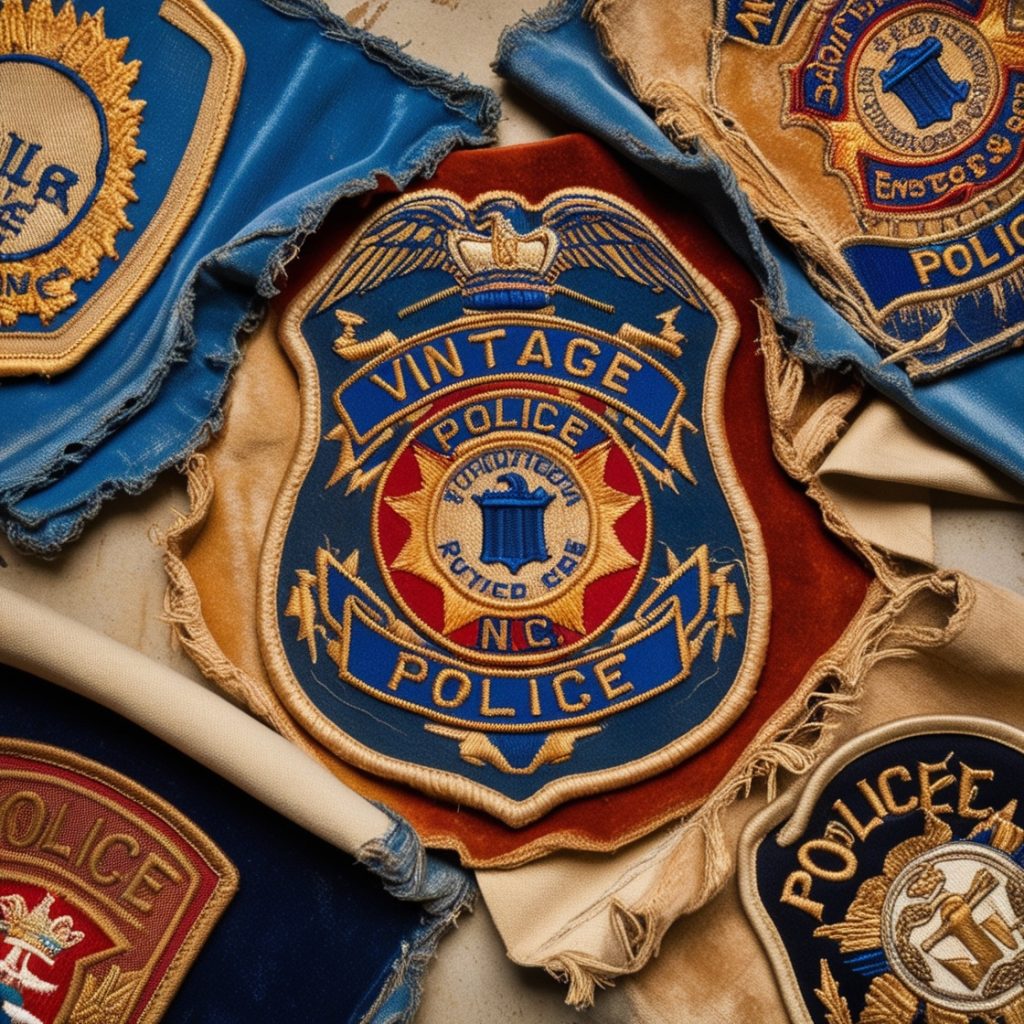The Story Behind the Badge
Imagine a police officer’s uniform without its signature patch. It would seem incomplete, missing a key element of identity and authority. Police patches are more than just pieces of cloth; they are symbols of service, honor, and the communities they protect. Have you ever wondered how these patches have evolved over the years? How did we go from simple, traditional designs to the intricate, modern patches we see today? Let’s embark on a journey through time to explore the fascinating transformation of police patches.
The Problem and Its Importance
Police patches have always been a crucial part of law enforcement uniforms, representing the values, history, and identity of the departments they belong to. However, as society evolves, so do the symbols and designs that adorn these patches. Understanding the evolution of police patches not only helps us appreciate the heritage and tradition of law enforcement but also sheds light on the modern values and technological advancements that influence current designs. By decoding this transformation, we can bridge the gap between the past and present, fostering a deeper respect for the men and women who wear these patches.
The Early Days: Simple and Symbolic
1. The Birth of Police Patches
The history of police patches dates back to the early 20th century when law enforcement agencies began to formalize their uniforms. The earliest patches were simple in design, often featuring basic shapes, bold letters, and a few symbolic elements like stars or shields. These patches were meant to be easily recognizable, establishing the authority and legitimacy of the officers wearing them.
2. Key Symbols in Traditional Designs
Police patches from the early days were characterized by their simple yet meaningful designs, each symbol carefully chosen to convey specific values and attributes associated with law enforcement. Let’s take a closer look at the key symbols found in these traditional designs and what they represent:
- The Star: Authority and Law Enforcement
One of the most universally recognized symbols in traditional police patches is the star, often depicted as a five or six-pointed shape. The star symbolizes authority and the power vested in law enforcement officers to uphold the law and maintain public order. It reflects the officer’s role as a guardian of the community, entrusted with the responsibility to protect and serve.
2. The Shield: Protection and Defense
The shield is another common element in traditional police patches. This symbol signifies protection and defense, representing the officer’s duty to safeguard the community against harm. The shield embodies the idea of the police as protectors, standing between citizens and the dangers they might face. It also symbolizes the officer’s personal commitment to upholding justice and providing a sense of security.
3. Eagles and Lions: Courage and Vigilance
Eagles and lions frequently appear on traditional police patches, drawing from their historical and cultural significance as symbols of courage, vigilance, and power. The eagle, known for its sharp vision and soaring flight, represents alertness and the ability to respond swiftly to threats. The lion, a symbol of strength and bravery, underscores the courage and steadfastness required in law enforcement.
4. The Fasces: Unity and Authority
The fasces, a bundle of rods bound together with an axe, is a lesser-known but historically significant symbol that appears on some traditional police patches. Originating from ancient Rome, the fasces represent unity and authority, illustrating the idea that strength comes from working together and that the power of law enforcement is derived from the collective support of the community.
5. The Scales of Justice: Fairness and Impartiality
The scales of justice are a powerful symbol of fairness and impartiality, often featured on traditional police patches. They represent the principle that law enforcement officers must balance the scales of justice, ensuring that their actions are guided by fairness and the rule of law. This symbol emphasizes the importance of objectivity and integrity in the police profession.
6. The Torch: Enlightenment and Knowledge
The torch, symbolizing enlightenment and knowledge, is another element found in traditional police patches. It represents the role of law enforcement in illuminating the truth, shedding light on criminal activities, and guiding the community toward safety and justice. The torch signifies the importance of education, training, and continuous learning in the field of law enforcement.
7. The Arrow: Direction and Determination
Arrows often appear in traditional police patch designs, symbolizing direction, determination, and the focused pursuit of justice. The arrow represents the proactive approach of law enforcement officers, who are always moving forward, seeking out crime, and working diligently to protect the community.
8. The Olive Branch: Peace and Harmony
The olive branch, a universal symbol of peace and harmony, is sometimes included in traditional police patches to reflect the ideal that law enforcement aims to create a peaceful society. It highlights the dual role of police officers as both enforcers of the law and peacekeepers, striving to resolve conflicts and maintain order without unnecessary violence.
9. The Crossed Batons: Discipline and Order
Crossed batons are a traditional symbol of discipline and order, often seen on police patches. They signify the structured and regulated nature of law enforcement, emphasizing the importance of discipline, respect for authority, and adherence to established protocols and procedures.
10. The Laurel Wreath: Honor and Achievement
The laurel wreath, historically associated with victory and honor, is another emblem found on traditional police patches. It represents the achievements and commendable service of law enforcement officers, honoring their dedication, bravery, and contributions to the community.
Regional and Departmental Variations
While these symbols are commonly found on traditional police patches, each department often incorporates unique elements that reflect their specific community or region. For example:
- Local Landmarks: Many patches feature prominent local landmarks, such as city halls, state capitals, or notable buildings, to highlight the department’s connection to the area they serve.
- State Seals and Flags: Incorporating state seals or flags into the design reinforces the department’s allegiance to state laws and its role within the broader jurisdiction.
- Mottos and Slogans: Many traditional patches include departmental mottos or slogans that encapsulate the values and mission of the police force, such as “To Protect and Serve” or “Integrity and Service.”
The Significance of Traditional Symbols
The use of these traditional symbols on police patches is more than decorative. Each element is carefully chosen to communicate the core values and responsibilities of law enforcement officers. These symbols serve as visual reminders of the principles that guide police work, including authority, protection, courage, fairness, knowledge, peace, and honor. They help to establish a sense of identity and pride among officers, while also conveying important messages to the public about the role and mission of the police force.
3. Regional and Departmental Variations
While many early police patches shared common symbols, each department often included unique elements reflecting their specific community or region. For example, patches might feature local landmarks, state seals, or mottos that highlighted the department’s connection to its community.
Isn’t This Just About Nostalgia?
Some might argue that focusing on the history and evolution of police patches is merely an exercise in nostalgia. However, understanding these changes is crucial for recognizing how law enforcement adapts to societal shifts and technological advancements. It’s not just about looking back; it’s about seeing how the past informs the present and future.
What Sparked the Change?
As we move forward, let’s explore what sparked the transformation from traditional to modern police patch designs. What factors influenced these changes, and how do they reflect the evolving role of law enforcement in society? Stay tuned to uncover the catalysts behind this fascinating evolution.
The Modern Era: Innovation and Identity

4. The Shift Toward Modern Designs
The transition to modern police patch designs began in the late 20th century, influenced by several factors, including advancements in technology, changes in societal values, and the need for enhanced functionality. Modern patches are often more detailed, colorful, and reflective of the diverse roles that police officers play in their communities.
As we have seen, traditional police patches are rich with symbolism and historical significance. However, as law enforcement has evolved, so too have the designs of police patches. In the next section, we will explore the factors that have influenced the shift toward modern designs, and how contemporary patches continue to honor these traditional symbols while incorporating new elements that reflect the changing landscape of law enforcement.
5. Technological Advancements in Patch Design
Advancements in embroidery technology have significantly impacted police patch designs. High-resolution embroidery machines can create intricate patterns and detailed images that were impossible with earlier methods. This allows for more complex and visually appealing patches that can include fine details like department logos, state seals, and even photographic images.
6. Reflecting Diversity and Inclusivity
Modern police patches often incorporate symbols and colors that reflect the diversity and inclusivity of the communities they serve. For example, some patches now feature symbols representing different cultures, religions, and ethnicities. This shift highlights the commitment of law enforcement agencies to represent and protect all members of their communities.
7. Incorporating Modern Values and Missions
Today’s police patches also reflect the evolving missions and values of law enforcement agencies. Many patches now include symbols of community service, public safety, and technological expertise. Elements like medical crosses, fire axes, and digital circuitry patterns emphasize the multifaceted roles of modern police officers, who often serve as first responders, investigators, and community leaders.
Examples of Modern Police Patches
1. New York Police Department (NYPD) Patch
The NYPD patch has evolved to include intricate details of the city’s skyline, reflecting the department’s connection to New York City. The patch also incorporates the Statue of Liberty, symbolizing freedom and justice.
2. Los Angeles Police Department (LAPD) Patch
The LAPD patch features a detailed image of City Hall, a symbol of the department’s service to Los Angeles. The inclusion of palm trees and the Hollywood sign highlights the unique identity of the city.
3. Toronto Police Service Patch
The Toronto Police Service patch includes symbols of Canadian heritage, such as the maple leaf and the Queen’s crown. The patch also features a balance scale, representing justice and fairness.
Bringing It All Together: The Role of Police Patches
Police patches are more than decorative elements; they are powerful symbols that encapsulate the essence of the law enforcement profession. By understanding the meanings behind these symbols, we gain insight into the values and traditions that guide police officers in their daily lives. These patches are visual representations of courage, readiness, and community service.
How to Decode Police Patches: A Guide for the Curious
For those eager to learn more about police patches, here are some tips to get started:
- Look for Common Symbols: Identify recurring symbols like stars, shields, eagles, and state seals. Each has a specific meaning tied to the law enforcement profession.
- Research Specific Patches: Many police departments have detailed histories of their patches available online. These resources can provide context and stories behind the symbols used.
- Ask a Police Officer: If you have the opportunity, speak with a police officer about their patch. They can share personal insights and stories that bring the symbols to life.
- Visit Police Museums: Police museums often have extensive collections of patches and memorabilia, along with information about their significance.
- Join Online Communities: There are numerous forums and social media groups dedicated to police memorabilia. These communities can be a great source of information and support.
Celebrating the Symbols of Service
In conclusion, police patches are rich with meaning, each symbol carefully chosen to reflect the values and history of the law enforcement profession. By deciphering these symbols, we can deepen our appreciation for the brave men and women who serve our communities. Next time you see a police patch, take a moment to reflect on the stories it tells and the heroes it represents. These patches are more than just pieces of fabric—they are badges of honor, embodying the spirit of service, sacrifice, and solidarity.
So, whether you’re a police officer wearing your patch with pride or a curious observer seeking to understand the symbolism, remember that each patch is a testament to the enduring legacy of those who dedicate their lives to protecting others. From old school to new age, every symbol on a police patch has a story worth discovering.
If you are interested in purchasing high-quality custom patches, feel free to call us at 1-866-903-4903 or fill out one of our free quotes here.




